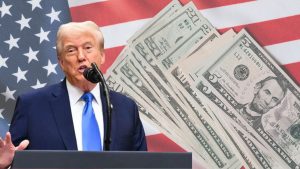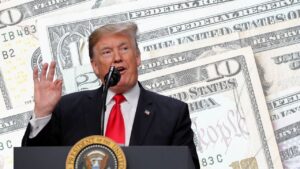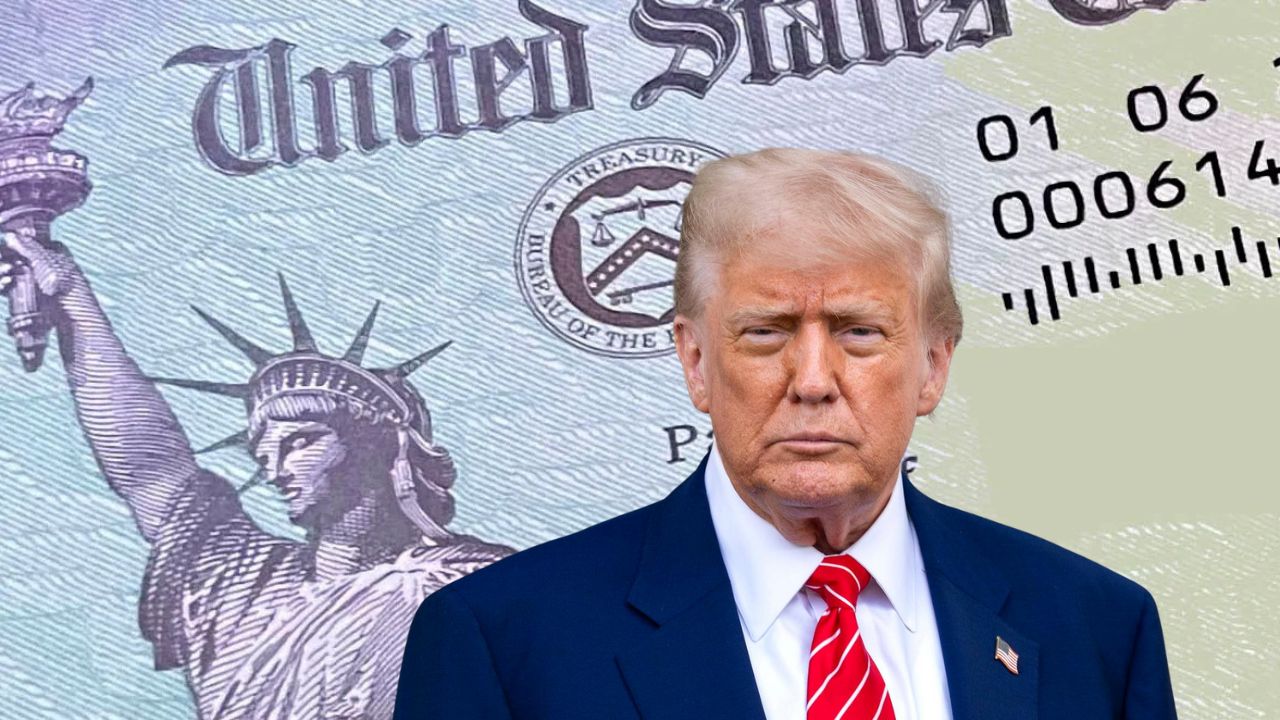When former President Donald Trump announced on Sunday that his administration would deliver $2,000 stimulus checks to most Americans — financed entirely through new tariffs on imported goods — it reignited one of the most politically charged debates in U.S. economic policy: who pays the price of protectionism.

$2,000 Tariff-Funded Stimulus Checks in 2025
In a post to his social media network, Truth Social, Trump described the proposal as a “tariff dividend” — a plan to redistribute revenue collected from foreign imports directly to U.S. citizens, while reducing the federal debt and, as he put it, “rewarding American workers for the strength of their country.”
“People who oppose tariffs are fools,” Trump wrote. “We’re bringing trillions back into America through fair trade and strong borders. That money belongs to the American people.”
Also Read Trump Proposed Giving Every American $2,000 Stimulus Checks: You’d Get It for Free
Trump Proposed Giving Every American $2,000 Stimulus Checks: You’d Get It for Free
If implemented, the measure could represent the most ambitious redistribution of tariff revenue in U.S. history, signaling a fundamental shift in how the federal government might use trade policy to fund domestic welfare.

A New Chapter in Tariff-Driven Economics
Since April, following what the White House called “Liberation Day,” Trump’s administration has expanded tariffs on a broad range of imported products — from steel and electronics to cars and agricultural goods. Rates now range between 10% and 50% on imports from China, Canada, Mexico, and the European Union.
According to Treasury Department data, these tariffs generated $195 billion in fiscal year 2025, marking a 20% increase from the previous year. Analysts at the Yale Budget Lab estimate the tariffs could yield as much as $2.6 trillion between 2026 and 2035, though such projections depend heavily on global market stability and the potential for retaliatory trade measures.

“This is an unconventional but not implausible use of tariff revenue,” said Dr. Laura Mendel, a senior economist at the Brookings Institution. “In theory, tariffs can generate large sums in the short term — but they also raise prices for consumers and disrupt supply chains, which can offset the very relief payments they fund.”

How the Proposed Stimulus Would Work?
Although few operational details have been released, Trump’s team has described the initiative as a direct payment program targeting the majority of U.S. households, similar to the stimulus checks distributed during the COVID-19 pandemic.
Key features — based on early statements from administration officials and sources close to the Treasury Department — are expected to include:
| Category | Details (as of Nov. 2025) |
|---|---|
| Payment Amount | $2,000 per eligible adult |
| Funding Source | Revenue from tariffs on imported goods |
| Income Threshold | Exclusion likely for individuals earning above $150,000 or households above $200,000 |
| Estimated Cost | $600 billion (based on population of 300 million) |
| Distribution Method | Direct deposit or mailed checks (details pending) |
| Timeline | Subject to congressional approval and Supreme Court ruling |
No formal legislation has yet been introduced, though insiders suggest the proposal could be folded into the recently passed “Big Beautiful Bill,” a sweeping tax reform package eliminating taxes on tips, overtime pay, and Social Security benefits.
Legal and Legislative Uncertainty
Despite the populist appeal of tariff-funded payments, the proposal faces significant legal and institutional hurdles. The U.S. Supreme Court is currently reviewing whether the White House has the authority to impose tariffs of this scope without congressional approval, under the International Emergency Economic Powers Act (IEEPA) — the same statute invoked to justify the measures.
During oral arguments last week, justices across the ideological spectrum expressed concern over the breadth of executive power. “If the president can declare an economic emergency and levy tariffs indefinitely, that’s not oversight — that’s delegation,” Justice Amy Coney Barrett noted during questioning.
An unfavorable ruling could upend the administration’s projected revenue stream, potentially derailing the stimulus plan before it reaches Congress. Still, Trump signaled defiance in an interview with “60 Minutes”, calling such an outcome “a very sad day for American workers” and promising to explore “other legal means” to sustain the initiative.
Economic and Political Reactions
Economists and trade experts are divided over the practicality of using tariff income as a stimulus mechanism.
“This is a politically brilliant idea but economically risky,” said Dr. Miguel Santos, director of the Harvard Trade Policy Center. “Tariffs are, in effect, taxes on imports. That cost is typically passed down to American consumers through higher prices — so people may receive a $2,000 check, but they’ll also be paying more for cars, electronics, and groceries.”
Supporters of the plan, including several Republican senators and populist commentators, argue that the proposal aligns with Trump’s broader vision of “economic nationalism.”
Senator Josh Hawley (R-Mo.), who previously introduced a $600 “Tariff Relief” bill in 2024, praised the president’s move. “This is exactly what we’ve been calling for — taking the proceeds from trade that hurts American workers and giving it back to the people who built this country.”
Critics, however, warn that the combination of high tariffs and domestic spending could stoke inflationary pressure. The Congressional Budget Office estimates that sustained tariffs of 20% or higher could add 0.8 percentage points to consumer inflation within a year, depending on supply responses.
Historical Context: From Protectionism to Populism
Tariffs have long been a tool of American economic policy, but rarely have they been tied directly to consumer payments. During the 19th century, tariffs were a primary source of federal revenue, but that changed after the introduction of the federal income tax in 1913.
The idea of “tariff dividends” resurfaced periodically — most notably during the Great Depression and again in the early 1980s — but none materialized into a sustained program.
“What’s happening now is a merger of two political traditions: protectionism and direct welfare,” said historian Dr. Elaine Rodriguez of Columbia University. “It’s an attempt to reimagine trade as a revenue stream for the people, rather than a tool for deficit reduction or industrial protection alone.”
What Happens Next?
For the stimulus checks to become reality, several conditions must align:
- The Supreme Court must uphold the administration’s tariff authority under IEEPA.
- Congress must approve the spending mechanism, likely through a supplemental budget or amendment.
- Treasury must establish a payment infrastructure — either reactivating the IRS’s pandemic-era distribution systems or creating a new platform.
Administration officials have hinted that the checks could be distributed as early as spring 2026, but only if the court and Congress clear the path by January.
Until then, uncertainty looms — both for families counting on relief and for industries affected by the tariffs.
FAQs: Trump’s $2,000 Stimulus Plan Explained
Who would qualify for the stimulus checks?
Most U.S. adults below a certain income threshold (likely $150,000 for individuals or $200,000 for households). Exact figures have not been finalized.
Where does the money come from?
From tariffs — taxes on imported goods — collected under Trump’s expanded trade measures.
When could payments begin?
Not before spring 2026, pending legal and congressional approval.
Will this raise prices on goods?
Possibly. Tariffs often lead to higher prices for imported goods, which can affect consumer costs.
Does this require Congress’s approval?
Yes. Even if the tariffs are upheld, Congress must authorize any spending on direct payments.
How does this differ from COVID-era stimulus checks?
Those were funded by deficit spending; this proposal is financed by tariff revenue — essentially a redistribution of trade tax proceeds.
A Shift in the Meaning of Economic Relief
If enacted, Trump’s “tariff dividend” plan could mark a turning point in how Americans understand economic relief — not as aid during crisis, but as a recurring benefit of assertive trade policy.
For working families, the promise of $2,000 may offer short-term relief. For policymakers, it raises deeper questions about sustainability, fairness, and the hidden costs of self-financed populism.
As Dr. Mendel observed, “The symbolism may matter as much as the money. This is not just about checks — it’s about redefining what America owes its citizens, and who pays for it.”

